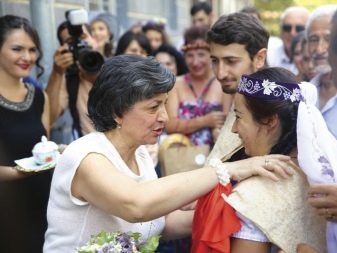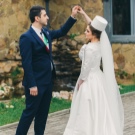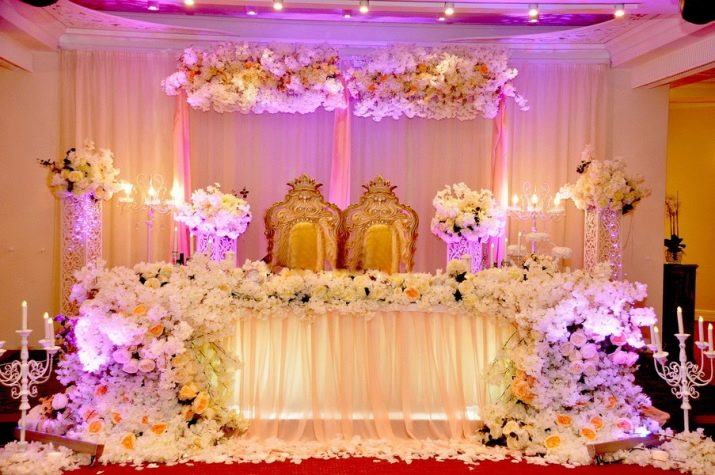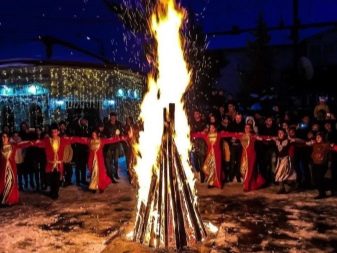The Armenian wedding is a very fun celebration of enormous proportions. Such a wedding is considered one of the most beautiful in the world. Of course, the modern celebration is already different from the event that was held several centuries ago, but all the same, the spouses observe the main traditions and customs. It should be considered in more detail the peculiarities of the wedding with the Armenians, as well as what are its differences from the celebrations of other nations of the world.

Matchmaking
Matchmaking is an indispensable stage that precedes the very celebration of the wedding. Previously, matchmaking was mandatory, but today many young people adhere to this tradition. The bottom line is that the groom must notify the parents of the future bride about their intentions. For this, a mediator or, as is commonly called, a matchmaker is sent to the girl’s house. In Armenia, the mediator is called midjord kin. She can only be a woman from the groom's family. She must be respected, have a good position in society. Even the groom's mother can successfully cope with this role. It is very important that the matchmaker be known to the parents of the future bride. Initially, the matchmaker comes without an open offer, she carefully and unobtrusively tries to find out the attitude of the future bride's parents in general to marriage, as well as to the groom.

After the so-called preliminary matchmaking, the matchmakers are sent to the parents of the future bride - Relatives of the future groom. Only men participate in the negotiations. The matchmakers tell the purpose of the visit and ask permission of the future bride's father for marriage.The decision is up to the father, who may hint at either consent or refusal. The father does not have the right to immediately agree to the proposal of the matchmakers, because it is believed that then he wants to quickly give his daughter in marriage. Only at the second meeting, the father directly expresses his consent, the terms of the engagement are immediately discussed, which is the next step before the wedding itself.


Engagement
Betrothal is a pretty important stage of pre-wedding preparation. It is after the engagement that the parents of the bride and groom begin to communicate closely, spend more time together, helping the young with the organization of the wedding. Grinding is carried out on a pre-selected day. Parents of future marriages gather in the groom's house, while his family is responsible for the treats. At the festive table, Armenian toasts are usually heard, in which guests wish the young long and happy married life. But this feast does not last all day, since then everyone goes to visit the bride's parents, where they also have a festive table.






According to Armenian customs, the most important at the engagement is the landed father, or Cavor. Usually the godfather of the groom or a worthy man from his family is invited to this role. It was Cavor who was honored to lead the bride with her friends to the table, at which the bride is presented with luxurious jewelry. After that, the Cavor announces that now the future newlyweds are engaged, while the groom must adorn the ring finger on his left hand with his beloved exquisite ring with a pebble.




It is on the day of engagement that it is customary to agree on the date of the wedding. It is discussed what the bride’s dress will be, what attributes will be used during the wedding ceremony itself, while attention is drawn to elements that are characteristic of the Armenian wedding. This day ends with another ceremony, during which the girls sing sad songs, because now the future bride needs to say goodbye to her father’s house, because after the wedding she will move to the house of her future husband. It is accepted that the last tune is “Uzundara”, and when it ends, the bride must leave the parental home.



Preparation for the celebration
Armenians adhere to traditions, especially when it comes to weddings. Preparing for this rather important and unique day also has some interesting customs and traditions.
- Brides of the bride. After the engagement, the groom should again come to the bride's house, but not alone, but with his relative. He must treat his beloved mother and sisters with various sweets. After that, the very next morning, the future mother-in-law treats the neighboring children with sweets, while she acts as a bride. If this tradition is respected, it means that now young people can openly see each other even before the wedding.
- Kyasum trill. This is another unusual, but very interesting custom. Its essence lies in the fact that the parents of the bride and groom meet to discuss monetary issues related to the wedding. It is worth discussing how many will be invited from each side.




When all traditions and customs are observed, the most important thing in preparation begins - the material stage. Usually organizers are hired for the organization. It is they who must find a room, purchase decor to decorate the whole celebration, draw up a menu for a banquet feast, send invitations to guests, draw up a script for the celebration itself. They are necessarily responsible for organizing weddings in the church, because it is there that the union at the Armenian wedding before the official marriage is made.


Holding a wedding
Most Armenian weddings take place in the fall or early winter. This period is the most favorable for the celebration, since the entire harvest has already been harvested, the young wine is already ripe. According to Armenian customs and traditions, the bride’s relatives should bring the dress to the bride.On the wedding day, close friends and relatives of the groom come to the bride, headed by a cowor - they take the bride from her father’s house. This action is accompanied by noisy songs and fun music.






The groom, having come to the house of the future wife, presents her “blue” to her relatives - This is a variety of fruit dishes, goodies, spirits, jewelry and, of course, a dress for the bride. Kavorkin is the wife of Kavor, who also plays one of the important roles on the wedding day, because it is she who dresses the bride in a festive outfit. According to traditions, it is customary for Armenians to give gold jewelry and money to young people for a wedding. But on this day, gifts are not only received by the couple. A large dish with traditional treats receives a favor from the mother of the bride.






Modern Armenian weddings are very fun, it is customary to have fun and dance, sing wedding songs. But according to tradition, the bride’s mother doesn’t take part in dances, because she’s saddened that her daughter has already grown up and leaves her father’s house. The dance of the bride and groom is not an important element, it can be seen quite rarely. The peculiarity of the Armenian wedding is that the bride dances with other guys that day, which allows her to check the girl for fidelity to her future husband. If a young woman behaves with dignity, not paying attention to other men, then she receives gifts from them.




After the official marriage, it is customary to meet the young family with honey, and lavash is thrown on their shoulders. This custom says that the life of the newlyweds will be sweet. And it is also customary to sprinkle with marriages on flowers, sweets, grains and even nuts with raisins. Armenian toasts deserve special attention, because they are a real decoration of this unforgettable day. The toasts of the Armenians are very beautiful, poetic, usually combined with various Armenian parables. The toasts use metaphors with landscapes of the surrounding nature, because Armenia is very beautiful, a country rich in unforgettable landscapes.






The first dance of the bride is very popular. Usually she goes to the center of the dance hall, and guests dance around her, while giving her the money. Thus, the so-called Sabbath is formed. Quite often, the bride devotes her first dance to her husband.
Wedding
An official wedding is only half the battle, because all couples are sure to get married. This ceremony also has many traditions and customs. But the main thing is that no one should go through during the wedding between the young. Usually this is followed by the Cavors, because at the wedding there are a lot of people who are rather inattentive to this requirement. During the wedding, the Cavor holds a scabbard and a sword crossed between themselves over the heads of young people. It is believed that it is metal that is able to protect a young family from various adversities.






Another interesting custom is held during the wedding. Using special shoelaces, the priest ties the hands of the bride and groom, while the ends of the shoelaces are necessarily covered with wax. Such shoelaces are usually called narotom. Only the priest has the right to remove them. Until the lace was removed, the young had no right to enter into close relations.
Gifts and wedding table
According to traditions, the Armenian wedding is celebrated for three days. Usually it is customary to slaughter a bull at a wedding celebration, and use its meat to prepare various delicious dishes. At the holiday tables there is always barbecue, an abundance of fruits and greens. On wedding day they give jewelry made of gold and, of course, money. Usually donated money for the wedding was collected by the mother of the bride. It is worth noting an interesting tradition of giving, which consists in the fact that all gifts, except money, are given to relatives by the groom.






Why can't you shout “bitterly”?
At a wedding with the Armenians, it is forbidden to speak “bitterly” to the young after the toast, and this rule also applies in other nations.The main reason for banning "bitterly" at a wedding is that it is ugly to show your feelings to everyone, especially since there has not even been a wedding night. The bride is still innocent, so the groom can only kiss his lover on the cheek after the wedding in the registry office. Usually, each toast at a feast ends with the word “carcass”.






After wedding ceremonies
- Sending a dowry. According to this Armenian rite, the parents of the newly made wife forward all the gifts of the young to their home. Today this tradition is already more playful in nature.
- Washing the bride’s head. Armenians had a right to see their mother and daughter after the wedding. Only on the first Saturday after the wedding could the mother come to her daughter to help her wash her hair, while she took shampoo and hairbrush with her.



- Making bonfires. This custom is held today. After the wedding, bonfires are lit, through which unmarried girls and boys jump to funny songs.
- Farewell to the house. This ritual is today more a formality, but many adhere to it. The father takes his daughter out of the house after the wedding, because now she moves to live with her husband. The bride’s father holds her hand and hands it to her husband’s father. During this celebration, sad music is played. The girl thanks her parents for everything, kisses their hands.




- Wedding night. According to tradition, in the house where the young will sleep, no one should be. Relatives went to sleep with friends. Only the bridesmaids could eavesdrop on the door of the house. On the first night, the young were forbidden to scream. After the first night, the guy felt embarrassed, so he went to his friends, and only in the late afternoon his parents brought home. The bride had to prove her innocence, therefore, after the wedding night, she showed the groom's family a bloody stain on the sheets. After that, they gave her silver coins and apples, and her mother - wine and chicken. If the wedding night went well, then several shots were fired into the air. But if the bride could not prove innocence, then she had to undergo a shameful ritual. She was put on a donkey, while backwards, and the animal was allowed along the main street of the village. Such a shame was seen by all the villagers.


Watch the review of the Armenian wedding in the next video.










